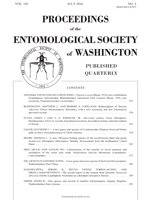The treehoppers Thelia bimaculata (F.) and Vanduzea arquata (Say) were studied in the southern Appalachians, with emphasis on delimiting their host-plant ranges. Previously thought to develop only on black locust (Robinia pseudoacacia), both membracids were found to use granite dome locust (R. hartwigii) as a host; nymphs of V. arquata also developed on bristly locust (R. hispida). Neither membracid became entrapped on the sticky stems of R. hartwigii, but only adults, trapped in glandular exudate, were observed on clammy locust (R. viscosa), whose more viscid stems apparently are unsuitable for treehopper colonization. Both tree-hoppers typically were positioned on black locust as described in the literature, but nymphs, particularly those of T. bimaculata, also were observed to occupy old (abandoned) burrows (tunnels) of the locust twig borer (Ecdytolopha insiticiana Zeller; Lepidoptera: Tortricidae). Ants (Crematogaster lineolata [Say], Formica subsericea Say, and other species) tended membracid nymphs inside excavated stems and also were found around exit holes of locust twig borer larvae. The southern Appalachians represent the center of diversity for Robinia, but nearly all previous field studies of the treehoppers were conducted outside the original range of black locust and probably also that of the tortricid twig borer. The membracids' behavior and host range might be expected to differ between the southern Appalachians, where the anttreehopper system on locust presumably has a long evolutionary history, and regions where members of the system are not native.
How to translate text using browser tools
5 August 2016
Thelia bimaculata (F.) and Vanduzea arquata (Say) (Hemiptera: Membracidae) in the Southern Appalachians: New Hosts in Robinia (Fabaceae) and Nymphal Use of Abandoned Cavities of the Locust Twig Borer
A. G. Wheeler, Jr.
ACCESS THE FULL ARTICLE
ant-hemipteran mutualism
attendant ants
black locust
Ecdytolopha insiticiana
R. hartwigii
R. hispida
R. viscosa





